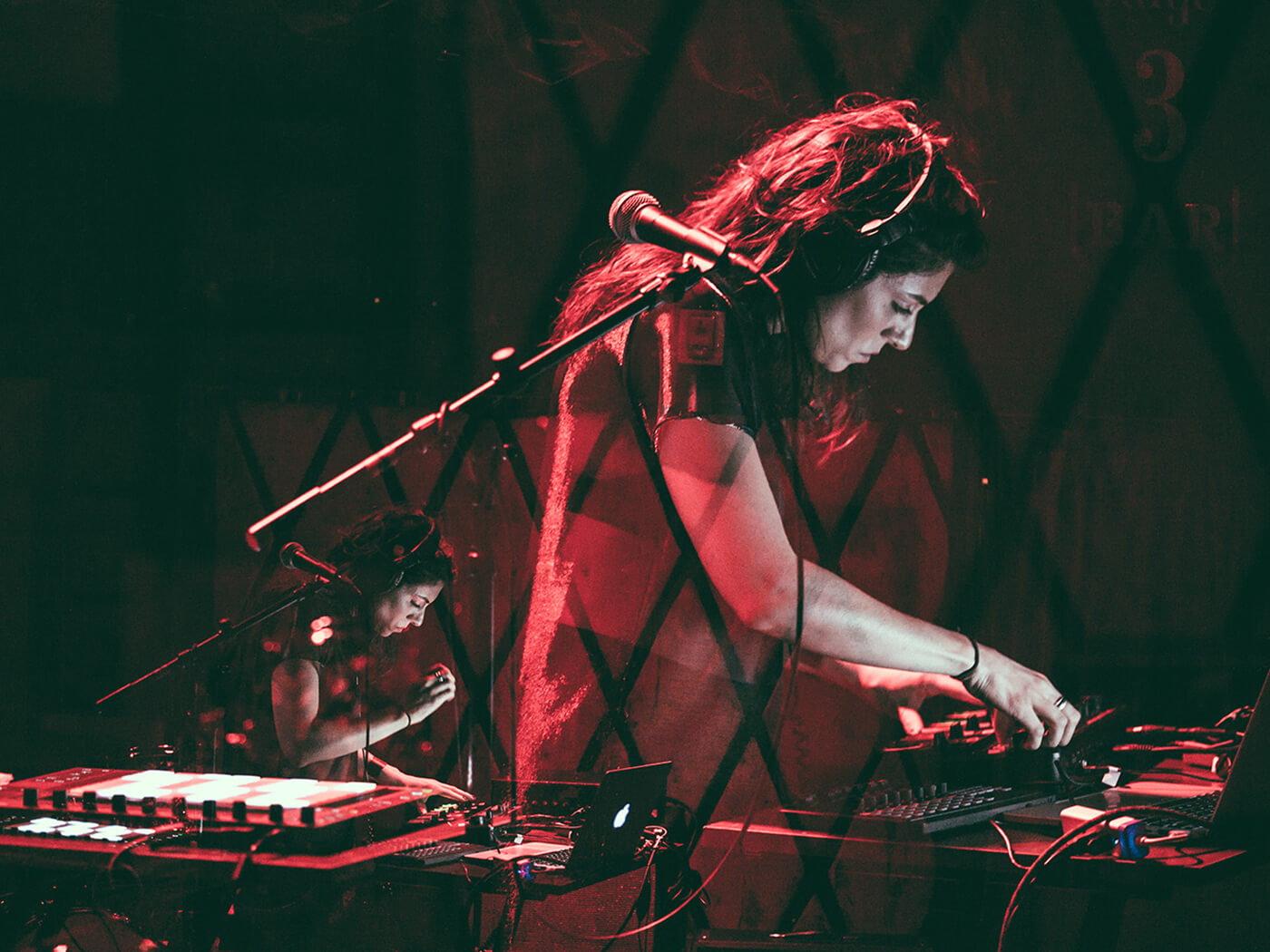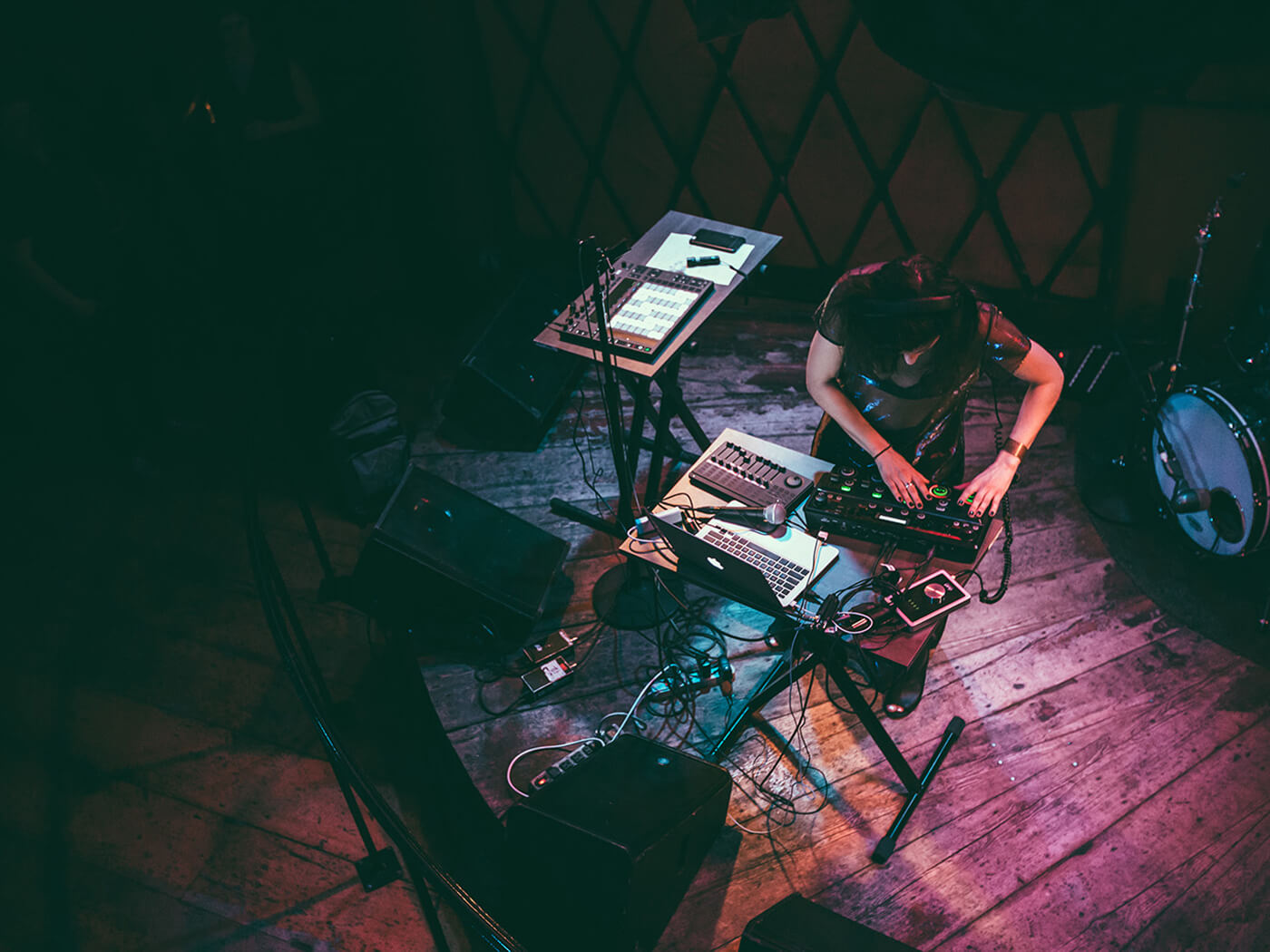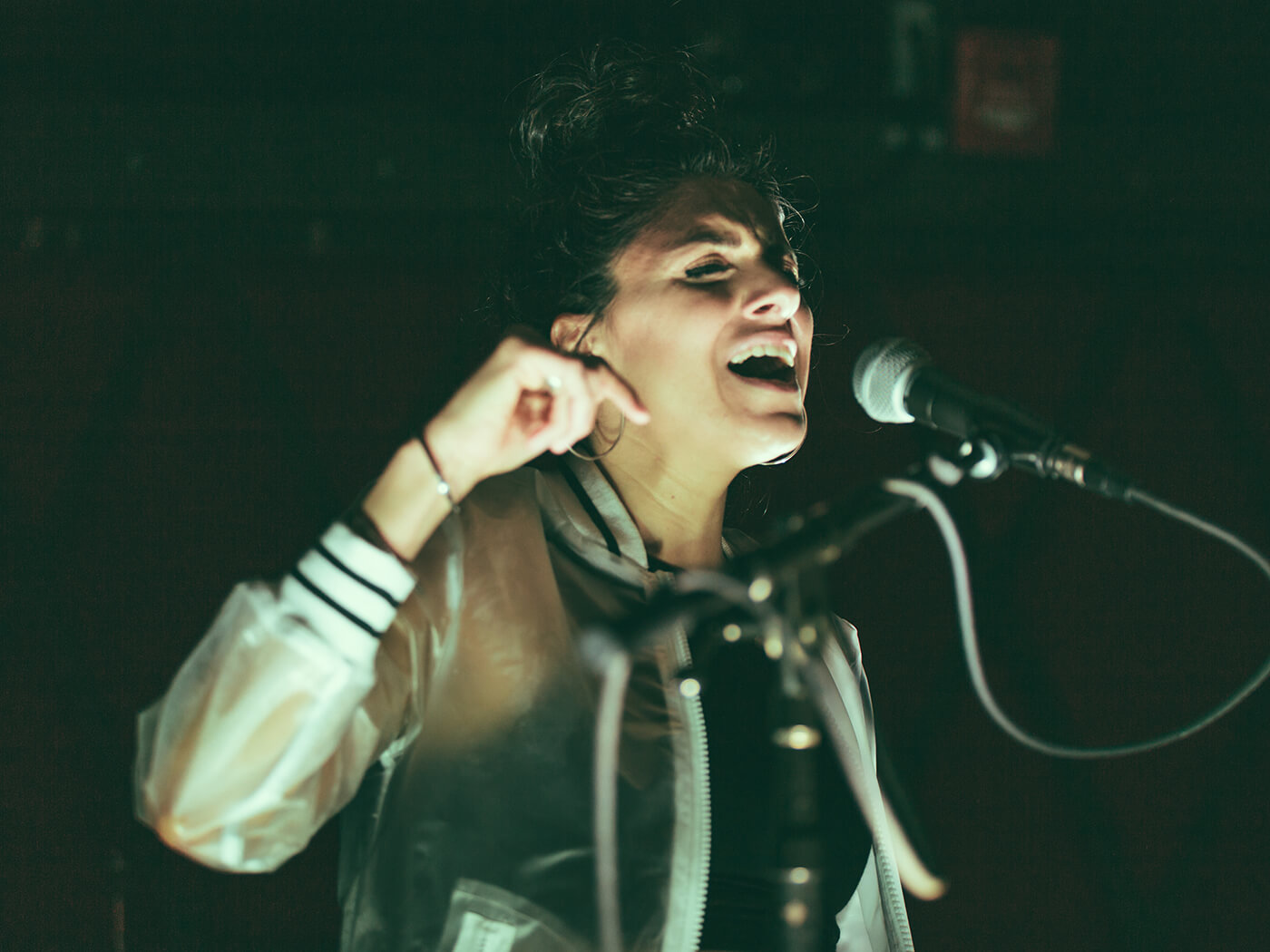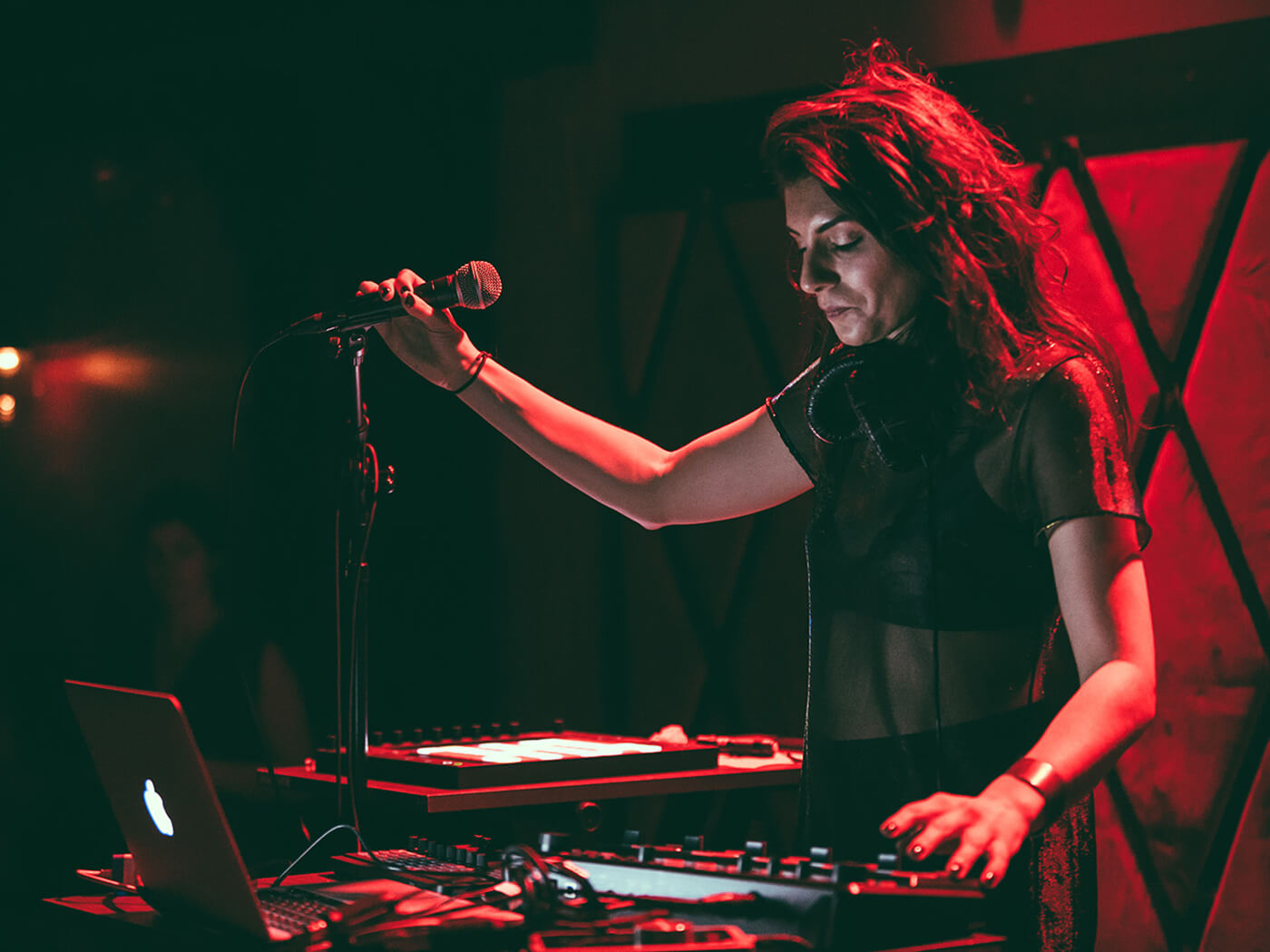“I can’t make feel-good stuff right now”: KYOSi on her current approach to making music
New York-based electronic musician KYOSi (aka Dani DiCiaccio) has channelled her frustrations with the various inequalities in society into some colourful and vital music. We speak to this up-and-coming artist about her process and the ambition behind her alter ego.

Images by Leonardo Mascaro
She’s been described by some as ‘experimental indie pop’, while others have referred to her as a skilled fuser of jazz and electronica, but for New York-based electronic-music artist Dani DiCiaccio – in the guise of her artistic persona KYOSi – the music she crafts isn’t designed to tick any specific boxes. “I think I have more fun when I abandon form and when I stop trying to fit something into a mould,” Dani explains to us, “though I do think writing in that way on occasion can be a fun exercise.”
KYOSi was created by the multi-talented DiCiaccio as a cipher for her various different projects in a range of media. She describes this character as encapsulating “sound, math, symmetry, beauty, wonder and colour”. Music is her main medium of expression, however and her self-produced, intricate mixes incorporate samples, deep, reverb-laden pads and some impactful low end.
Her recent EP Negative Space was released over the summer of 2019, and contains compositions that are fascinating from both a musical and thematic perspective. “I’d say that in its simplest form, this EP is about class – it’s a theme that I’m thinking about all the time.” Dani explains.
“The world right now is trending in an interesting direction, the lines between classes have blurred, but also in some respects, they have become more stark than ever. I was brought up in a hard working-class family of Italian immigrants. I’m actually in the midst right now of reclaiming my Italian citizenship. As I do that, I’m looking through documents pertaining to my great, great grandfather who arrived in the US by boat. But I’m just one of many millions of people who have ancestors who arrived here that way. There’s so many of us all over the world.”
Space to grow
Dani’s journey into music-making began when she was a small child. “Making music as a kid was always important. I listened to the radio all the time, I wouldn’t really play albums, it had to be the radio. I liked the idea of hearing the people who were also pulling the levers of making the radio shows, as well as the songs that they were playing. There was something about that that appealed to me. My musical education experience was a little bit different to what I wanted though, it felt like more ‘let’s put you into this jazz choir’ or into a musical-theatre production, as opposed to exploring the music-making process itself. Everything had a performative nature, but at that time I was getting more studious when it came to sound. I think that often education pushes you into the ‘singing and dancing’ side of things and I did begin to resent it. I never wanted to be a Broadway star!”
Dani studied voice at the Eastman School Of Music, Later, while studying Ethnomusicology at Ithaca College, she simultaneously managed a non-profit studio for young people in the inner city. After making a few (rather commercially tinged) tracks under the pseudonym of More Dani, she decided to create her current, more sonically experimental persona, KYOSi.

We ask Dani about the tools she uses in this creative guise: “Ableton Live is really the beginning and end of my music-making setup. It all starts with Live and then, when the music is performed and delivered to an audience, it’s all sequenced through Live, too. I got introduced to it around 10 years ago. I really hated it at first. I always thought that Session View was very confusing. More straightforward DAWs like Logic and Pro Tools made a lot more sense to me at that stage. I really resisted it at first – and I didn’t like the grey interface, either. It really wasn’t until someone explained the capabilities of working with vocals in live performance that I gave it a shot. Now Ableton Live is so integral I see it as both a creative tool and a performance tool.”
Speaking of the live sphere, we ask Dani about her KYOSi live rig. “Well, Ableton Live is the central hub. I use an Apogee Duet interface and I have a whole vocal signal chain that I put my voice through. Sometimes, I kill that and just sing totally raw with nothing on it. It’s fun to switch between the two back and forth. I also use a Boss RC-505 Loop Station, which is fantastic, it’s really tactile with those five big buttons. I can throw a lot of vocals on there. I have an Ableton Push, too. I could do all the looping stuff with Push, but I actually prefer to use the looper. Then there’s some other pieces of gear that I throw in every now and again. I used to work at Dubspot and there were times when we got paid with gear (for better or worse). They gave me this weird Japanese synth once that’s really fun to work with, it makes some really cool noise. I’ve got a Korg Minilogue that I sometimes use and a range of chorus, overdrive and delay guitar pedals that I’ll throw into my vocal chain when I feel like it.”
Negative to positive
Despite Dani’s watertight live rig and many performances under her belt, she still feels a sense of trepidation before going on stage. “I really just love being in the studio, I really like it. I have anxiety about performing, it is very scary. I know how to do it, but it doesn’t mean I like doing it. Once I begin a show, however, it’s the greatest thing of all time. But everything leading up to that makes me want to throw up most of the time!”
Dani has been receiving guidance from a familiar figure to MusicTech readers: “I’ve been working with Laura Escudé and working with her to design my live show has made me more excited than ever to get out there. But I still have nerves, of course. Being in the studio is just so chill. I can spend as much time as I want on one thing. So if I had to pick between the two, I’d say I prefer being in my studio.”
We ask Dani if she recorded all of her latest record Negative Space in her studio. “Up until the mixing process,” she confirms. “I take my stuff to be mixed by Richie Beretta, who has a really awesome studio in Queens, which is also where I’m based. The second bedroom in my apartment is my own studio. On Negative Space I worked with Todd Brozman, whose studio is in Harlem. I think the making of that record took about a year, all in all. I’m getting faster. In the past, it took a lot longer to finish things. I think now that I’m freer and quicker with the technology, it aids the efficiency.”

Dani goes on to advise that: “If you’re going to be an electronic music artist, then you’ve got to also be a programmer, in some sense. As I get faster with the technical stuff, I’m able to turn things out much quicker.”
Dani tells us more about Negative Space and the three songs that make up the EP. The title track features a haunting piano melody, underpinned by some cavernous bass, while All I’ve Had showcases her layered vocals and lyrically tackles gender inequality.
However, the track which Dani tells us she’s most proud is Boo Radley, a song which underlines the increasing gap between classes in the western world. “I’m inspired by what I’ve been able to do and what my brothers have been able to do. I wonder if my great, great grandfather were still around, what he’d make of all this. I’m a relatively careful person, but I don’t feel like making happy pop music is the right approach right now. The climate doesn’t inspire it. There’s so much going wrong with the United States at the moment. This is not a happy time and I can’t make feel-good stuff right now. To me, it comes back to class, the ‘haves and the have nots’ are so divided.”
Boo Radley is perhaps the best distillation of this concept, with a mix that features haunting, spectral vocals, bleeping, insectoid synth and a relentless beat. The song’s lyrics were inspired by Dani’s increasing awareness of gentrification. “Boo Radley is sort of like a one-off, really. I’d made that frantic beat, Todd and I began to pass it back and forth and we both really liked it. There’s a siren on there and really intense drums. It almost felt like a tech-house track in its first iteration. When I wrote the lyrics, I was walking home from a rehearsal at a space that was three storeys underground. It was the basement of this gorgeous luxury apartment building and I’d got to thinking about how the space deep beneath this rich, luxurious building was filled with starving, hard-working artists. The space itself was kind of gross, but it was cool and inspiring, too.
I started thinking about this gentrification machine that is happening because there is art beneath it, but is not inclusive of the artists who are making it a lot of the time. As far as the To Kill A Mockingbird reference goes, well, that is one of those literary characters that I’ve always been drawn too. He was misunderstood and mysterious – I can identify with that. I don’t typically have a tonne of literary references in my songs. The character just appeared in my head when I was making that song. In the song, the character of Boo Radley is reinterpreted as a modern everyman, a cog in the machine who is just hard working. It’s not necessarily an allusion to the narrative of To Kill A Mockingbird, but it’s taking that character and putting him in a new context. It’s a captivating character. “
Subway sounds
KYOSi’s socially conscious and politically aware lyrics are often generated during her frequent daily rides on the New York subway. “Often when I’m sat on the train here in New York City, I feel endlessly inspired. I love the subway. When I don’t have to be somewhere, I sometimes bring sketches and rough mixes of tunes and play them on my headphones and just listen and write in my head.” Dani tells us. “Songs normally begin with some sort of seed. From the germ of the idea, I’ll go home and start building the track up. I usually start with the bass – this gives me a ‘floor’ with which I can build around. I can then expand on the top of it. But it’s beneficial to have that stability established early on. I’ll usually add a drum track and then perhaps a pad, something really simple. Then I’ll get a vocal scratched down.”

We ask Dani what her perception is of making a living as an artist in an increasingly economically tough industry. “There’s two main takeaways from what I’ve learned from my own experience in the industry. One is that you need to build a 360-degree holistic view of music and the music business. If you have to get a job, then get a job in music – stay as close to it as you can and learn as much as you can, learn about publishing, learn about education, learn about demographics. When people share knowledge with you, you need to just soak it all in!”
Dani continues: “Also, learn to deal with knockbacks and that ‘no’ really means ‘no – for now’. I learned that because I’d had a lot of setbacks and a lot of ‘nos’ working my way up. If you can, take the feedback and accept it, sift through that feedback and apply what resonates with you and what doesn’t. It will help make you a better artist. If a blog or venue or collaborator says no, then work harder to improve your music and go back to them. People are frequently deterred by these gatekeepers. But for the people who are persistent, I see some growth and development.”
Dani has certainly been a persistent force herself over the last few years and a series of creative projects loom on the horizon for her. “I’m putting together a live show, which I hope to be debuting really soon. I’ll be producing a podcast which I’m super-excited about, for a group called Camel Assembly. This is a group of women all over the world and it’s focused on artists and activists – two groups of people who are very close to my heart. I’ve also started working on a video project, linked with my music called Test Subjects, which I hope to debut next year. I started combing through a bunch of archival footage and found some really interesting clips of testing and focus groups. I thought it was really moving, so right now, I’m doing some basic editing and scoring it to my own music.”
Dani’s focus is very much on the here and now, creatively speaking, as we discover when we ask what element of her career she’s most proud of. “I think Negative Space – this whole collection of songs I’m really so happy with. I hope that I’m saying that every time I release something new. It’s important to keep focused on the current thing you’re working on and make it the best thing you’ve ever done.”
For more KYOSi, follow her Facebook or check out her website for the latest music releases. Read more interviews with artists and producers here.